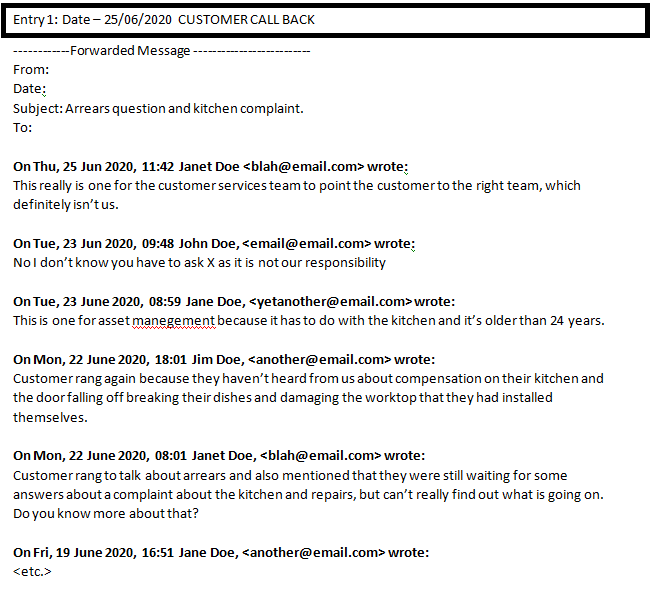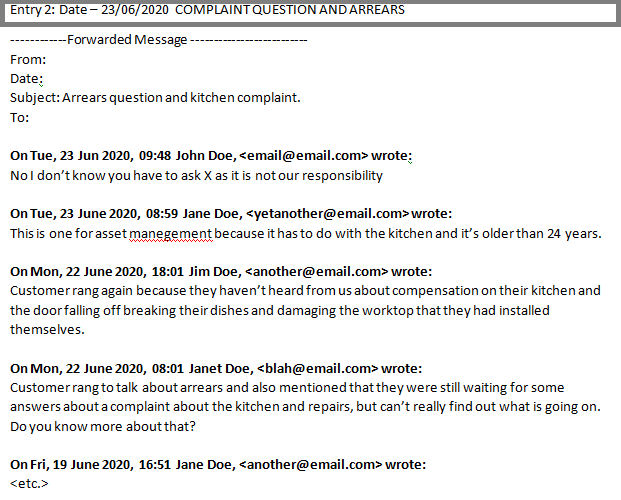
Everyone who has ever worked with me knows I regularly mention the dangers of, and the need to improve our understanding of the signs and effects of digital exclusion. Unfortunately, people always assume that I’m talking about digitally excluding tenants or applicants.
And yes, that is important. We are riding an unstoppable tidal wave of digital transformation, that changes how we deal with administrative affairs. That is why we need to make it is as easy as possible for people to do things right. We have to do so especially in sectors where the forms decide whether you have a roof over your head, or receive adequate support services.
So, that’s great! We acknowledge that the information put into these systems is important! We have also said it has to be as digitally inclusive as possible to make sure we make as little errors as possible. The question then is, why do we not focus more on the quality of our own data entry?
I feel that the sector gets things horribly wrong by not recognising, or even ignoring, staff digital incompetence. There are two areas where this is most prevalent. The first is in the lack of understanding of their role in maintaining data and data integrity. The second is more practical digital skills. In this article I will focus on the first area; the lack of understanding of data, data relations and their (crucial) role in keeping people safe and the business running.
Intermezzo: A little exercise for housing staff
Before I go any further, if you are reading this, work in housing, and have access to your systems right now, please do this exercise.
Take 10 minutes or so.
Randomly select some addresses in your system.
Look into the system entries and/or contact moments.
Look at some complaints descriptions, repairs logs, calls about rent income and arrears.
Basically, scroll through some of the transactional data where the person responsible for data entry was your staff/colleagues.

So….How impressed are you with the quality of those data? Be honest. Be totally honest. If you’re not sure, let me propose the following scenario.
How not to: Data Entry #1

A lot of tenants call in to report their repairs, where staff log the request onto the system. Going by the systems I have used so far, there is a subject line and a description field available in most cases. In the subject line you give the short and sweet summary (e.g. heating in living room not working). The details providing any extra information that could improve your chances the repair is fixed at the first visit go in the description field.
Are you confident that all the tickets for your operatives or external contractors are correct, efficient and professional? And what if you want to automate your satisfaction surveys and send emails using data from your system. Do you think it makes you look professional and trustworthy, or do you risk sending something like the examples below?
Both examples are fictional, but based on things that I have actually seen when looking through transactional/repairs data over many years, in both the UK and in the Netherlands.
Dear <name>,
Fictional Example 1
On <date> you reported a repair with the following description:
Kiitchen Repairs
Tnt called this morning saying Kichen tap nt working asks fix as soon as posible becos tnt has no dish washeer, but have suggested they can wash up in bathtub upstairs and put on routine repair. Tnt also rang about >3000 rent arrears. Call Forwarded to inc team.
We really want to know what we’ve done right and were we would need to improve our service, <etc.>
Or like this:
Dear <name>,
Fictional Example 2
On <date> you reported a repair with the following description:
[DON’T VISIT ALONE] WINDOW REPAIRS URGENT MAKE SAFE
Tnt reports windows on ground floor not closing properly. Urgent repair make safe. Please don’t attend alone as this customer is known to be violent (suspected alcoholic) (see notes).
We really want to know what we’ve done right and were we would need to improve our service, <etc.>
In Example 1, the language used is very unprofessional and filled with mistakes. The suggestion to use the bath tub does not sound very understanding of the situation either. I don’t know about you, but my back starts aching thinking of doing the dishes hanging over my bath tub. Also, getting grease and other stuff in my bath tub wouldn’t be something I’d enjoy doing.
The mention of arrears also isn’t something that an operative (let alone an external contractor) should have any knowledge of for a variety of reasons. And, if this reaches the customer in a survey if they have experienced some (legitimate) delays in the repairs, they might think it was because they are in arrears. I’d raise complaint about how my information was dealt with either way if I where them.
Example 2 is a clear example of, well, a lot as well. It is only natural, and in fact good practice, to want to protect your staff or external contractors from any potential harm. Because, yes, there might be people with violent dispositions living in a home that you manage! Still, there are more professional, and indeed correct, ways of ensuring staff safety.
The majority of, if not all central housing systems, have flagging options that trigger or provide alerts for staff when opening an account. Alerts that tell them about any special needs, warnings and considerations. It is up to staff to make sure that before booking an appointment and/or entering someone’s home, that they consult the system. There are many considerations that might be of influence on carrying out the job, whether it is risk of violent behaviour, medical needs, or the request for female operatives if the female tenant has requested this (e.g. because they have been the victim of male on female abuse).
How not to: Data Entry #2

Many organisations have the goal to be able to help as many customers at first point of contact (FPoC). Whoever you email, call or speak to as a customer, that member of staff should be able to either answer the question or set things in motion that helps to resolve any issues a customer might have.
That is why many organisations have a Contact Management System (CMS) accessible to anyone in the business where contact moments with (or about!) the customer are logged. If a customer tells you ‘I rang a week ago about X, and I want to know why I haven’t heard anything’, anyone with access to the CMS should be able to have a look and find out what is happening.
Now, please consider the two example, fictional, contact entries below for the same fictional address:


Now, imagine you are speaking to a very frustrated and fed up customer on the phone. The one from the Example 3 and 4. The customer wants to know what the status of their compensation request is; they haven’t heard from you in a week. They want you to ‘just’ have a look in the system to see what they’re at, how hard can it be?
My first issue would be to not audibly sigh with the customer on the line; or show anything on my face if it were face to face. It would be difficult for me not to show my embarrassment for the way this has clearly been bounced off by half the organisation. Everyone is saying ‘not my responsibility’.
The second challenge would be knowing were to start and trying to find an answer to the customer’s question. Assuming I first of all see just the subject lines in the overview, the information could be anywhere.
My third task would be weeding through the entire emails that are copied into a tiny field, including the email’s meta-data! This means endless scrolling and more scrolling, reading, mumbling. Maybe at this point putting the customer on hold, or a promise (for someone else) to ring them back, and of course another contact entry on top of all of this.
A fourth question is: how are other teams, such as the performance team, going to use these data? There is no way you can run any useful reports using, for example, textual analysis on this, filtered on certain topics.
Joining the Dots: It’s all connected!

Housing Associations rely on their staff’s ability to do more than switch on a computer and click on the right icon on their desktop to open their most-used application and just select ‘log off’ in the Start menu when they leave for home, closing all the running applications in one go. Or at least, that’s what they should. Reality, I have noticed, is different.
However, it doesn’t (or shouldn’t) take much effort to see that within organisations such as housing associations, offering such a wide variety of services, people are working who have a lot of different digital skill levels.
My first observation is that there is a significant lack of understanding of what happens to data once one person has hit ‘submit’ and ‘done their bit’ for ‘their job’ and their team.
In an organisation with as many different roles as a housing provider, there are a lot of different data entry points that come together in yet another application. Repairs staff might seem to operate completely separate from policy and performance staff. They work in different parts of the building, and using completely different systems/applications to do their jobs. However, more often than not the data input from repairs and it being correct and reliable is crucial to a performance officer to be able to do their job correctly, which in turn means the performance officer can provide information on how the repairs team could reduce their workload.
It’s all connected, and you need people to know this to stay afloat!
What to do? Take Data Integrity seriously! But REALLY seriously this time…

So, in conclusion, if you want to improve your data integrity, and with that your services and tenant satisfaction with them, you have to make sure your staff are up to the task.
We have to make sure everyone understands what digital data are, do, and what their role is in making sure these data are correct. This means we, as a sector, have to start demanding more of ourselves and our staff when it comes to digital skills and understanding. Before I’ll leave you to ponder, and maybe write some considerations about this yourself, below I’ll list 5 (connected) suggestions that could get you going.
6 Suggestions on how to take Data Integrity seriously

1. Simply (dare to) ask more from your staff in terms of digital competency and be more critical of errors.
Every interview and assessment should include some (role-specific) data entry task(s). It wouldn’t be weird to require a customer adviser to be able to touch type, without errors.
At the same time, existing repairs staff and income officers should equally be capable of using a variety of devices. They should be able to update records, whether they are in their car or behind their desks, without any errors.
2. Introduce regular and mandatory Data Integrity Training.
Upon starting a new role in a new organisation, members of staff have to complete a training program. We all know them: GDPR, Health and Safety, Equality and Diversity, the whole lot.
The massive gap(ing hole) is Data Integrity Training, teaching and reminding members of staff of the importance of their role in keeping data of excellent quality.
A lot of how training happens ‘on the job’, but often in isolation and by a colleague who shows them their way of doing things and what is most important to keep in mind. Over time, this always encourages work-arounds to spread, putting your data integrity at risk.
3. Ensure your organisation has at least one person dedicated to improving and maintaining data integrity.
Appoint a Data Integrity Expert who provides essential (and mandatory) data integrity training and advice to minimise risk of work-arounds taking hold and departments working with data in their own silos alone.
Ideally, this person sits within, or at the crossroads of, Business Improvement and IT. They work closely with Development, Performance and Business Intelligence teams. They keep on top of how data should be stored and used so that your reports paint the right picture.
This is not something that goes one way. It fits within a well-thought out Software Development Life Cycle (SDLC) approach to working. An approach where learning from usage and development in other parts of the organisation, should inform further development or adjustment.
A Data Integrity Expert is instrumental not only because they make sure staff knows how to use the system. They also make sure that systems are set up in such a way that they are user friendly and logical to use in terms of filling out the right information in the right place in the right way. If you want people to do the right thing, you have to make it as easy as possible for them to do that, and as difficult as possible to do the wrong thing.
4. Ensure your organisation has clear and up-to-date data integrity manuals and rules.
I mentioned ‘right information in the right place in the right way’. The Data Integrity Expert should provide and work with a framework and documentation that clearly set out expectations for staff.
The framework and documentation should explain ‘the one correct way of doing things’ in a concise, simple and accessible way. This way the organisation has a clear benchmark; a standard to assess staff by, and (refresher) training materials for new starters and existing staff alike.
5. Show (and continue to show) staff the bigger picture and how they are an integral part of it.
A lot of people, including myself, need (and want!) to understand the ‘why’ and ‘how’ of things; they need a context. Don’t just teach people how to do their bit well. Make sure you show (and continue to show) them why it is important they do their bit well. If they understand how their bit fits in with that what others (need to) do to, it’s easier to do the right things right.
6. Acknowledge Digital Tools are just that: tools, not solutions.
Think about the devices and applications your staff use more critically. Especially in terms of suitability and training required to handle those devices and applications.
I will write more about that in my next article about data integrity, digital inclusion and exclusion and how it affects your staff; I’ve already written half of it and cut it out of this article to keep things readable!




One thought on “The Digital Threat From Within: The Need for Data Integrity Experts”